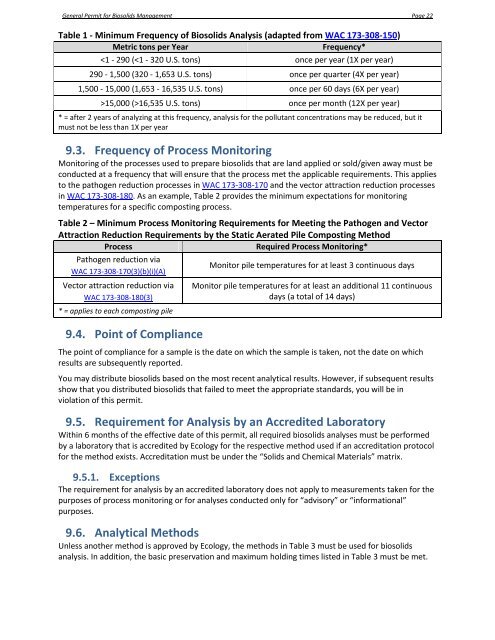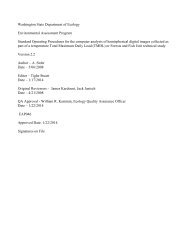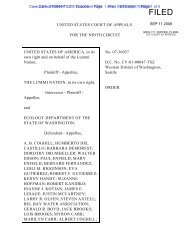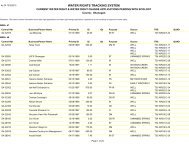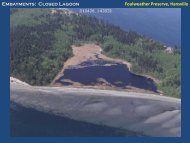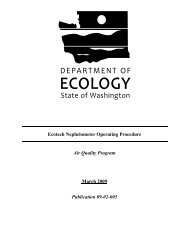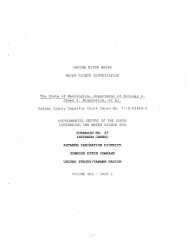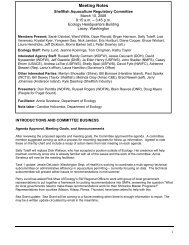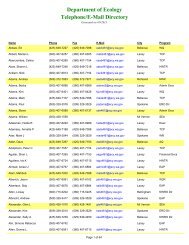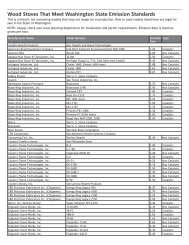General Permit for Biosolids Management - Washington State ...
General Permit for Biosolids Management - Washington State ...
General Permit for Biosolids Management - Washington State ...
Create successful ePaper yourself
Turn your PDF publications into a flip-book with our unique Google optimized e-Paper software.
<strong>General</strong> <strong>Permit</strong> <strong>for</strong> <strong>Biosolids</strong> <strong>Management</strong> Page 22<br />
Table 1 - Minimum Frequency of <strong>Biosolids</strong> Analysis (adapted from WAC 173-308-150)<br />
Metric tons per Year<br />
Frequency*<br />
16,535 U.S. tons) once per month (12X per year)<br />
* = after 2 years of analyzing at this frequency, analysis <strong>for</strong> the pollutant concentrations may be reduced, but it<br />
must not be less than 1X per year<br />
9.3. Frequency of Process Monitoring<br />
Monitoring of the processes used to prepare biosolids that are land applied or sold/given away must be<br />
conducted at a frequency that will ensure that the process met the applicable requirements. This applies<br />
to the pathogen reduction processes in WAC 173-308-170 and the vector attraction reduction processes<br />
in WAC 173-308-180. As an example, Table 2 provides the minimum expectations <strong>for</strong> monitoring<br />
temperatures <strong>for</strong> a specific composting process.<br />
Table 2 – Minimum Process Monitoring Requirements <strong>for</strong> Meeting the Pathogen and Vector<br />
Attraction Reduction Requirements by the Static Aerated Pile Composting Method<br />
Process<br />
Required Process Monitoring*<br />
Pathogen reduction via<br />
WAC 173-308-170(3)(b)(i)(A)<br />
Vector attraction reduction via<br />
WAC 173-308-180(3)<br />
* = applies to each composting pile<br />
9.4. Point of Compliance<br />
Monitor pile temperatures <strong>for</strong> at least 3 continuous days<br />
Monitor pile temperatures <strong>for</strong> at least an additional 11 continuous<br />
days (a total of 14 days)<br />
The point of compliance <strong>for</strong> a sample is the date on which the sample is taken, not the date on which<br />
results are subsequently reported.<br />
You may distribute biosolids based on the most recent analytical results. However, if subsequent results<br />
show that you distributed biosolids that failed to meet the appropriate standards, you will be in<br />
violation of this permit.<br />
9.5. Requirement <strong>for</strong> Analysis by an Accredited Laboratory<br />
Within 6 months of the effective date of this permit, all required biosolids analyses must be per<strong>for</strong>med<br />
by a laboratory that is accredited by Ecology <strong>for</strong> the respective method used if an accreditation protocol<br />
<strong>for</strong> the method exists. Accreditation must be under the “Solids and Chemical Materials” matrix.<br />
9.5.1. Exceptions<br />
The requirement <strong>for</strong> analysis by an accredited laboratory does not apply to measurements taken <strong>for</strong> the<br />
purposes of process monitoring or <strong>for</strong> analyses conducted only <strong>for</strong> “advisory” or “in<strong>for</strong>mational”<br />
purposes.<br />
9.6. Analytical Methods<br />
Unless another method is approved by Ecology, the methods in Table 3 must be used <strong>for</strong> biosolids<br />
analysis. In addition, the basic preservation and maximum holding times listed in Table 3 must be met.


